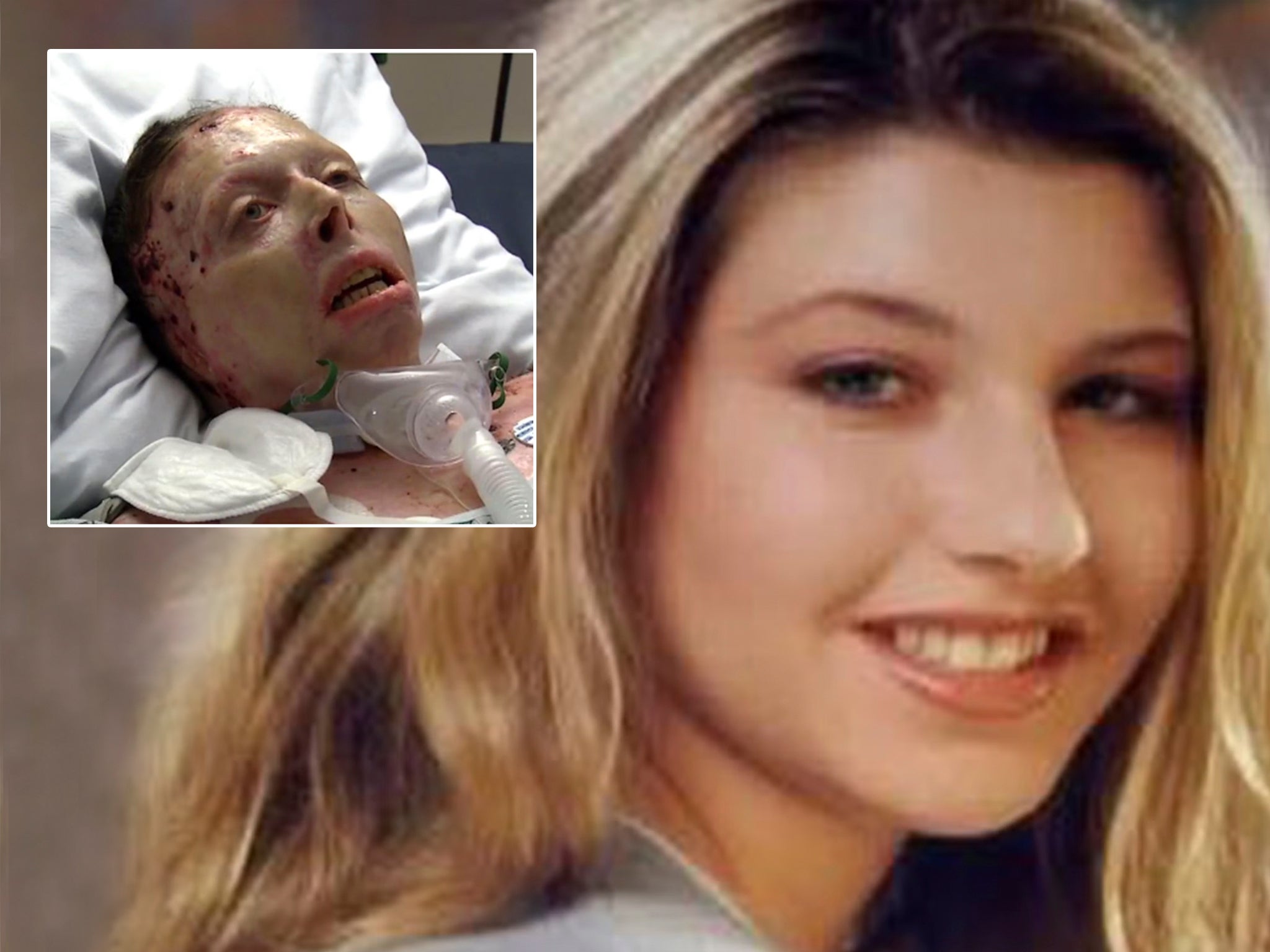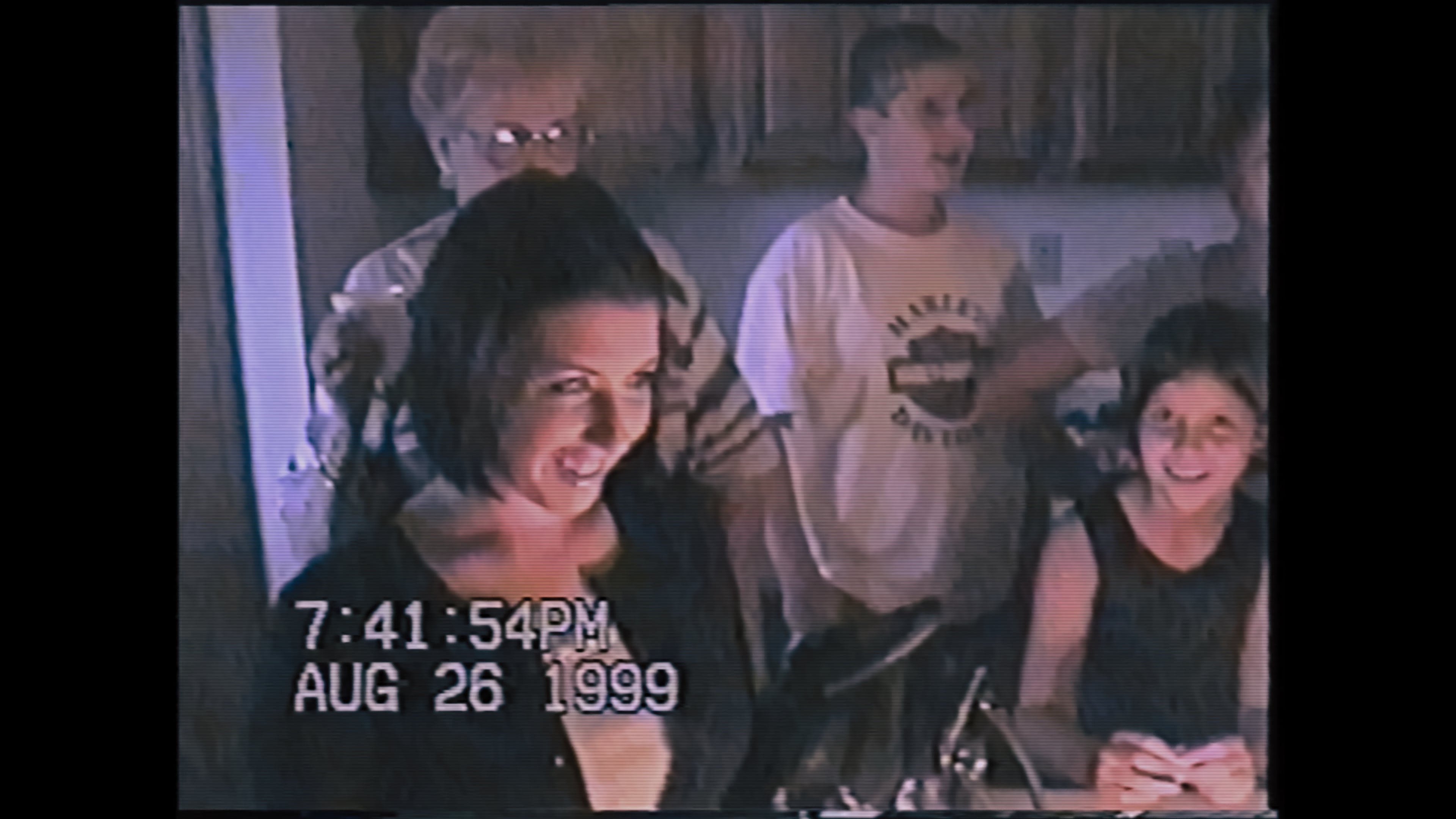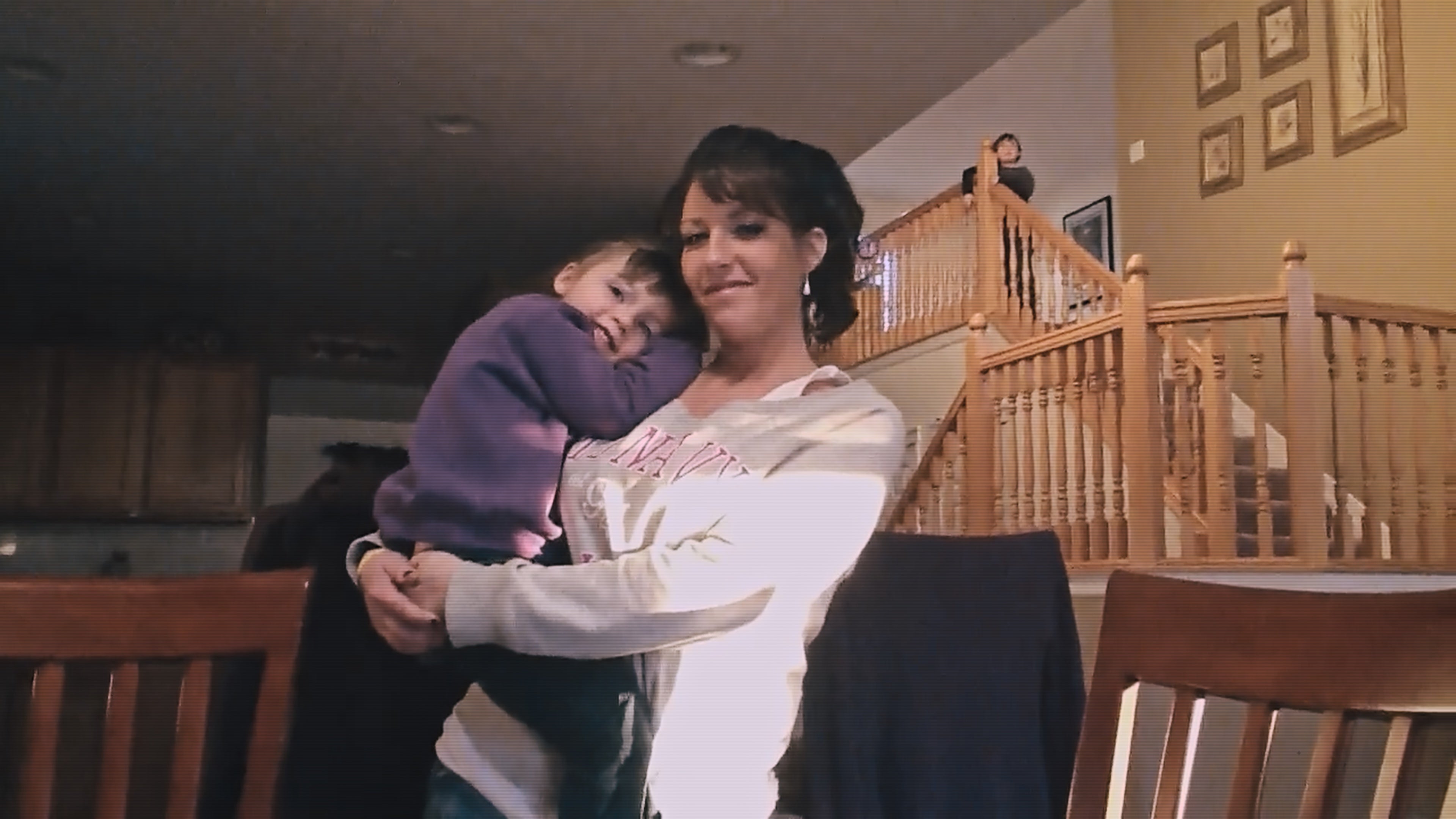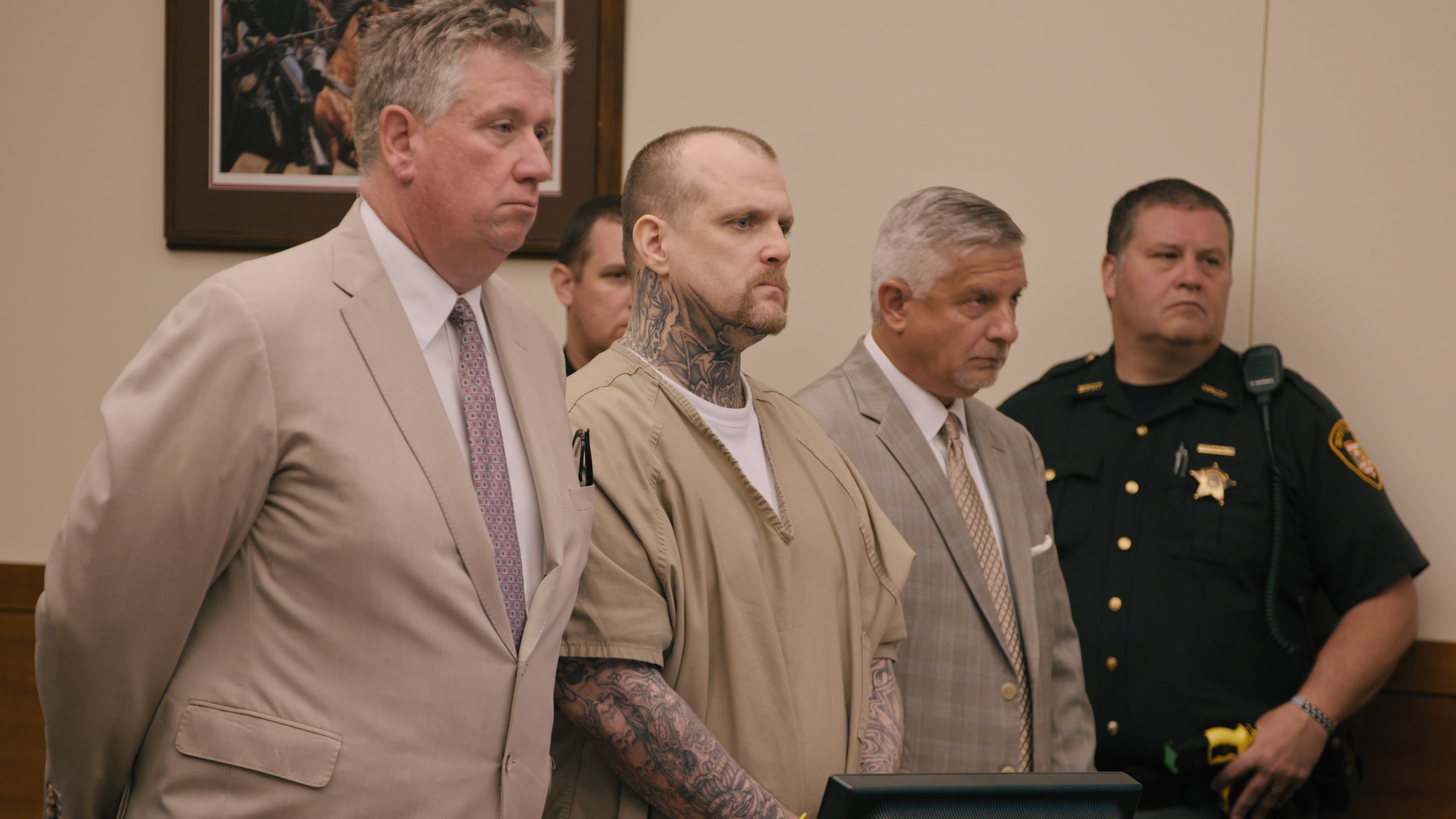She was burnt alive by the man she loved. Then Judy Malinowski testified at her own murder trial
Ohio mother Judy Malinowski miraculously survived for almost two years after her boyfriend doused her in gasoline and set her alight. Suffering unimaginable pain, she used that time to fight for other victims and record testimony in her own murder trial that sent her attacker to prison for life, writes Sheila Flynn

Speaking from her hospital bed – missing hair, skin, ears and fingers after suffering burns to more than 90 per cent of her body – Judy Malinowski raises a deformed right hand and stares down a video camera. The word “frail” doesn’t even come close to describing the appearance of the young mother. It’s hard to believe she is even alive.
Judy’s voice is steely, belying an unfathomable strength and determination from a body on the verge of giving up. The arson victim is talking through the live feed to her lawyer and then to the attorney representing Michael Slager, the boyfriend who’d tried to kill her.
Within months of giving the deposition, Judy would be dead. Those videotaped conversations would prompt a historic development within the Ohio court system – allowing a murder victim to testify at their own trial.
That’s exactly what Judy did, as she personally addressed the judge and jurors from the grave. Slager was sentenced to life without parole.
The tragic case is chronicled in The Fire That Took Her, a documentary that was released on Paramount+ on 23 May.
Judy not only made history with her posthumous testimony. Her story and advocacy also helped push through a state law that adds up to six years to sentences for offenders who attack and disfigure victims with accelerants such as gasoline.
Legislators unanimously passed Judy’s Law and it was signed by the governor, Judy’s two daughters at his side, the same week as her funeral.
“This woman contributed to American legal precedent,” director Patricia Gillespie, who first read about the story in a newspaper piece that didn’t even make the front page, tells The Independent. “It’s a wild story. Everybody should know about this woman.”
Judy grew up in suburban Ohio, where she doted on her sister and brother and enjoyed a happy childhood, even winning beauty pageants and being crowned homecoming queen. Her idyllic life was thrown into chaos, however, when she was diagnosed with ovarian cancer as a young adult; she beat it once but was told in 2006 that the cancer had returned.
Doctors performed a full hysterectomy on Judy, but she became addicted to opiates during recovery at a time when the drug epidemic was exploding across the United States. When Judy’s insurance ran out and she could no longer access prescriptions, she turned to the streets for heroin. Judy herself says this in the documentary, which utilises video footage filmed by family and detectives.
Relatives helped care for Judy’s two young daughters as she worked thorugh her addiction and tried to get back on her feet; she seemed to be making great progress until she began dating Michael Slager.
The documentary says that Slager contacted Judy on social media, and the pair became inseparable from their first date onwards. Unbeknownst to her family, neck-tattooed Slager had a lengthy record with offenses ranging from theft and stalking to child endangerment and domestic assault.

During her relationship with Slager, Judy fell back into addiction. He would buy her drugs, according to the film, despite not using them himself. It created a toxic cycle leaving her controlled by and dependent upon him. The pair fought often; it was one of those fights, while Judy was on her way back to rehab in 2015, that would ultimately turn deadly.
During the altercation by a gas station on 2 August of that year, Judy threw a soda at Slager; he responded by dousing her with gasoline. Surveillance footage from an ATM across the street shows Slager head back to his black truck, only to return in half a minute with a lighter.
Seconds later, Judy’s entire body was engulfed in flames as Slager looked on.
A frantic 911 caller alerted authorities. Slager began attempting to pass off the attack as an accident. Judy was whisked to the hospital, where she was not expected to survive.
“In the burn world, we have an equation for mortality, which is based on the patient’s age, and percent burn,” Stacy Best, one of Judy’s nurses, says in The Fire That Took Her. “And in Judy’s case, she was 31 at the time of the burn, I believe, and approximately 80-plus percent burnt. So that made her like 110 percent mortality.”
As Judy fought for her life, detectives were investigating what had really happened outside that gas station. It was the ATM surveillance footage - in addition to eyewitness statements - that almost immediately tore to shreds Slager’s account.
“It looked like a movie scene,” Lead Detective Chad Cohagen says in the film, adding that the footage was “clearly showing that they were arguing, and then Michael dumped gas over her. So we knew right away that Michael’s story ... he had lied to us. For me, that scene has played out in dreams more times than I can count.”
As determined authorities worked on building a case, Judy lay in a coma for months, her life hanging by a thread.

“I could probably prosecute prosecute for another 20 years and not get a case that is so right for the death penalty,” Assistant Prosector Warren Edwards says in The Fire That Took Her. “And really, for the first several months of this case, we were we were playing the delay game. It sounds terrible, but we were basically waiting for Judy to die so that we could charge Mr Slager with the homicide. And we got a call one day that she was awake, which is a call I never expected to get.”
The prosecutor said that it was the “first homicide case I’ve handled where I got to meet the victim.”
Judy’s explanation of her attack is chilling as she strains to speak after miraculously emerging from her coma.
“I don’t think words can describe what it feels like to have your whole body set on fire,” she says in the film. “I thought for sure I was dying. I just prayed to Jesus to please forgive me for my sins and to take care of my children, and that was it. I blacked out. I don’t remember anything until I woke up in the hospital.”
Mr Cohagen recalls how he had “never seen trauma like that to a human body that wasn’t deceased.”
“I remember leaning in to talk to her, and she doesn’t have any ears to hear,” he says in the film. “So I don’t even know if she can hear me.”
Judy would undergo more than 50 surgeries, code seven times and suffer excuciating procedures and skin grafts, many of them failed.
Slager, meanwhile, was charged with aggravated arson and felonious assault. He pleaded no contest when the possibility was raised of Judy testifiying via video link, which would unquestionably make jurors “hate” him, his lawyer says he told his client in the film.
The judge sentenced Slager to the maximum penalty allowed under the law - 11 years - and lamented that she could not keep him behind bars for longer.

“You really do seem like one of those people that have no soul, and you need to be incarcerated,” she told Slager in court. “That’s all I have to say.”
Judy and her family were heartbroken at the light sentence. Despite constant pain, she fought for Ohio state law to change to increase sentences for attackers who leave their victims permanently disfigured.
“There was this part of her that wanted to make it and to live to fight for every other woman that had been through something like that,” her sister, Danielle Gorman, says in the documentary. “She definitely wanted the law to change. And she was willing to do whatever she needed to do to help change the law.”
Her nurse, still clearly incredulous at Judy’s strength, says it was a “miracle that she survived with her spirit intact and her will to help other people intact.”
Judy, in support of the legislation, talks in the film about how the arson attack “destroyed my life, my family’s life, my kids’ lives ... the laws of justice are not fair.”
With her help from her hospital bed, the measure passed and was signed into law just months after Judy passed away.
Before that, prosecutors who were just as irate as Judy about Slager’s paltry sentence approached her about recording testimony for her own inevitable murder trial. It had never been done before, and they had to argue using similar cases, though not homicides, where victim depositions had been utilized.
Franklin County District Attorney Ron O’Brien, speaking in the film, says he considered it “a stroke of genius to come up with the idea of taking a deposition where she could testify from the grave at a subsequent homicide trial.”
Judy’s condition was deteriorating nearly 18 months after her attack, but her pain medication would have to be significantly reduced to ensure her lucidity during testimony.
Nonetheless, she agreed. The film is painful to watch as Judy’s body strains to allow her forceful, powerful deposition.

After she threw a drink at him during a fight, she says, Slager “ran around to the other side of his truck, and he got these cans of gasoline that he kept in the back of his truck ... he ran around me and started pouring gasoline, started at my head and worked his way down. Some got in my throat as he did that. That burnt really bad.”
Calling him “evil,” she explains how Slager “backed away from me for about 30 seconds; I kept telling him to please help me and “Stop” and “I’ll get in the truck, I’ll go with you” ... and he pulled a lighter out of his pocket, and he started walking towards me.
“i just remember crying and begging for help, and he lit me on fire,” she says. “And the look in his eyes ... his eyes went black, literally. After I was set on fire and he backed away, his eyes just turned black as I screamed for his help. And he did nothing.”
When Slager’s attorney cross-examines her, asking about her drug history and other details, Judy more than holds her own and, at times, even talks over him. She recounts how Slager got her re-hooked on heroin, bought her the drugs and had previously threatened her life.
“I called the police and told them Michael was going to kill me and I needed help, but the detective did nothing about it - so here I am,” she says, before adding: “You have to understand, on August 2nd, I was set on fire, thrown on the ground and burnt, 95 percent of my body. It’s really hard for me to try to keep track of everything that happened in this horrible relationship.”

Judy gave her deposition in early 2017; less than five months later, on 27 June, she passed away. Slager was subsequently charged with murder and her testimony admitted into the trial.
In July 2018, Slager pleaded guilty and was sentenced to life in prison; Judy made clear that she did not want him to receive the death penalty, hoping he would find religion while in prison, according to the film.
Her obituary praises her “courageous and miraculous 23 month battle for her life,” outlining how Judy’s case inspired the change of legislation to extend sentences of criminals of felonious assault who have disfigured their victims ... She was pivotal in the passage of this law by enduring excruciating pain to be able to testify in her own case.
“In spite of her extreme pain, her beautiful smile shined through her permanent scars, her disfigurement and her tears,” her obituary reads.
That’s the Judy who Ms Gillespie came to know while working on The Fire That Took Her.
“I didn’t have the privilege of meeting Judy in real life,” she tells The Independent. “But the absence that she created in the lives of these people that I’ve come to care about very deeply shows a tremendous amount of love, and humour, and grit - and somebody who was really ready to get her life together ... and it was cut short, because we haven’t figured out a way to handle these cracks in the system that she slipped through, right?
“We haven’t figured out a way to handle the medical industrial complex and Big Pharma. We haven’t figured out a way to handle addiction, we haven’t figured out a way to, most importantly, handle domestic abusers, repeat offenders and to sentence these people properly when they do commit these crimes.”
She says she feels that, “in some ways, Judy is representative of a lot of us, or a role model or a figurehead for a lot of us, or women who survived domestic abuse.
“She could have really been easily cast in this archetypical role of a victim, which in American society tends to be very passive, to attract a lot of pity,” said Ms Gillespie. “And instead of playing that role out, she completely subverted that idea and became a hero.”
Join our commenting forum
Join thought-provoking conversations, follow other Independent readers and see their replies
Comments